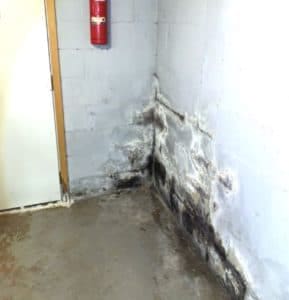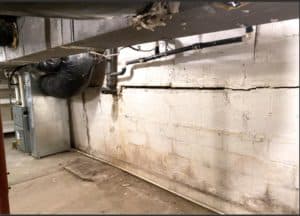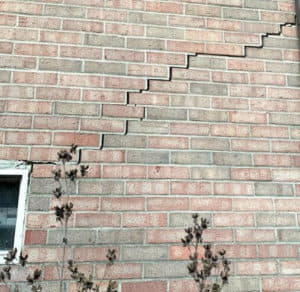The Connection Between Wet Basements and Foundation Problems

Originally published 3/1/19, updated 7/7/21
We all know that water is an essential part of life and a massive force of nature. Hurricanes, tidal waves, and floods are examples of water at its most dangerous. But water can be a major issue at a smaller scale, too. Did you know that excess rain can damage your home’s foundation?
Since our start in 1996, Acculevel has helped more than 30,000 homeowners restore strength and stability to their homes. A family-owned and operated business, we specialize in waterproofing and foundation repair. This may seem like an unusual combination- these services use very different products! But there is more overlap between the two than you might think.
Homeowners are often confused when we recommend water drainage as part of a foundation repair. So in this article, we’re going to explore the connection between foundation problems and water intrusion in your basement.
How Does Water Get Into Your Basement?
It doesn’t matter if your foundation is constructed of concrete, brick, or stone- these are all porous materials. Water can and will seep through your basement wall (or floor). As it does this, it forms a path that gradually wears down and forms a crack.
If your foundation is made of concrete block, the water will seep through the outer block and pool into the hollow core of the blocks. It could stay there for an extended period of time, before finally building up enough to go through the inner block into your basement itself.
Water In Your Basement Creates Problems for You
Of course, you know when water gets into your basement it causes issues. It can ruin items in storage, spoil drywall and carpeting- in short, it makes a soggy mess.
Adding to the potential mess, water or excess moisture in your basement feeds biological growths like mold and bacteria. It also makes your basement a more attractive environment for pests like termites. Softer wood- like floor joists that have been in a damp basement for a while- is an ideal nesting spot for unwanted insects.
 This photo was taken by an Acculevel project manager during a free estimate appointment. Water has been seeping into the corner, allowing biological growth to form.
This photo was taken by an Acculevel project manager during a free estimate appointment. Water has been seeping into the corner, allowing biological growth to form.
Water Outside Your Basement Also Creates Problems For You
The really frustrating part about water damage is that the water doesn’t have to intrude into the basement to create problems.
Hydrostatic Pressure
When it rains, the soil around your home absorbs as much water as it can. If you have more water than the ground can manage, the excess water just keeps moving. This is a major issue, because your foundation is built to support your home. It’s designed to hold firm and resist the weight of your home pressing downward. It is not so great at resisting lateral pressure, which comes from the side.
In other words, your basement is not a dam. But when water pushes against your foundation, it is treating your home as if it is a dam. The pressure this water is exerting is called hydrostatic pressure- and it will damage your foundation.
 This photo was taken by an Acculevel project manager during a free estimate appointment. Hydrostatic pressure has created a long horizontal crack in the foundation, and now the wall is bowing inward.
This photo was taken by an Acculevel project manager during a free estimate appointment. Hydrostatic pressure has created a long horizontal crack in the foundation, and now the wall is bowing inward.
Signs of Hydrostatic Pressure
As you can see in the above photo, hydrostatic pressure creates long horizontal cracks in basement walls. Sometimes, you will see a zig-zag type of crack in a wall that is made of concrete block instead of (or in addition to) the horizontal crack.
If you have a bowing wall like this, I’d encourage you to read an additional blog after this one: It is Urgent That You Fix a Bowed or Bulging Basement Wall, and Here’s Why.
Repair Methods for Hydrostatic Pressure
A cracked or bowing wall is not something to take lightly, or to procrastinate repairs. That wall is threatening the stability of your home. The repair methods for a leaning or bowing wall vary, depending on how far the wall is bulging inward.
If your basement walls all appear intact, but you have water intrusion on a somewhat regular basis, you should consider waterproofing your basement. This is a great way to manage the water that gets into your home and relieve the stress of hydrostatic pressure at the same time.
Erosion
Erosion is another way water outside your foundation causes problems for your home. If water washes away some of the soil under your foundation, it will shift. This shifting is referred to as settling, and it causes damage throughout your entire home.
Settling is damaging because it doesn’t happen evenly. Water takes the path of least resistance, so it erodes whatever area is easily moved. This tends to be one corner or section of your foundation. Your foundation material doesn’t deal with this well; concrete is a rigid material that won’t flex or bend. This means when one part of your foundation sinks, it strains under the pressure, then cracks.
Other parts of your home also lack flexibility- wood beams, window and door frames, flooring, stairs, drywall, etc. This means a stress at the foundation level has a sort of domino or ripple effect, through your home.
 This photo was taken by an Acculevel project manager during a free estimate appointment. The cracks in the ceiling indicate the foundation is settling at this end of the house.
This photo was taken by an Acculevel project manager during a free estimate appointment. The cracks in the ceiling indicate the foundation is settling at this end of the house.
Signs of Settling
There are three easily identified symptoms of a settling foundation.
- The first is cracks in the drywall. This is especially true if the cracks are around window or door frames.
- If you see any cracks near doors or windows, open these entry points and check for ease of motion. If the foundation is pulling against the home, the framework will also be strained, and this will interfere with the openability (seems fake, but it is a word).
- Cracks on the outside of the foundation- usually in a zig-zag pattern. This is not the same as a bowing wall- those zig-zag cracks occur on the interior of your foundation.
 This photo was taken by an Acculevel project manager. This crack is a sign the corner of the home is settling and pulling away from the rest of the house.
This photo was taken by an Acculevel project manager. This crack is a sign the corner of the home is settling and pulling away from the rest of the house.
Repair Methods for Foundation Settling
If your foundation is settling, it needs to be stabilized with helical piers. This means it won’t settle any farther, so the damage won’t get any worse. It may be possible to lift the foundation a small distance, to close cracks- but this depends on specific details about your home and property. This is one of the reasons you need to be particularly careful when you hire a foundation contractor to make repairs.
If the contractor is not well-versed in foundation repair, it is entirely possible that they will make repairs in the wrong area. The location of a foundation crack is not an absolute indicator of which area is settling. And there are reasons besides settling that you might find a foundation crack. (This is why we stress three major indications for settling.) A good rule of thumb is: if the contractor does not use a rotating laser level to verify their diagnosis, you need a second opinion.
Does Your Home Have Any of These Symptoms?
Have you seen cracks in your home, had water in your basement, smelled something musty? Not sure how significant it is, or you want more information about it? Please use our free comprehensive symptom checker to evaluate what you’ve noticed.
If You Need a Contractor to Evaluate Your Home
The first step is to look for an experienced foundation company and make an appointment. Before you sign a contract for any service, always verify the company is reputable, insured, and accredited by the Better Business Bureau. If you’re not sure what to ask, use our guide for questions to ask a contractor.
Do you live in Indiana or the surrounding area? If so, contact Acculevel and request a free estimate. We will schedule an appointment with one of our friendly and knowledgeable project managers. They will meet you on-time, listen to your concerns, evaluate your home, and recommend the best course of action for you, to keep your home strong and healthy for years to come.
